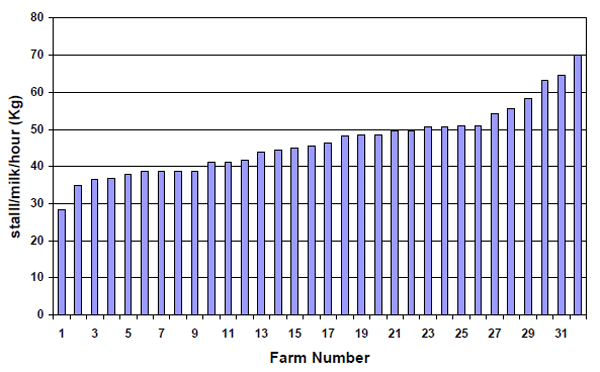Introduction
Lactation in the dairy cow is influenced by various management factors as well as the milking equipment. Milking efficiency is a combination of proficiency of the milker, operation of the milking equipment, and cow factors including udder shape, temperament and physiological traits.
As dairies grow larger, the desire to milk more cows in less time has resulted in the need to monitor the management of the milking parlour and the milking process. Optimal premilking cow preparation has been proven to be an important step in achieving maximum milking speed, milk yield and quality without compromising gentle and complete milking Reneau and Chastain 1995, Fuhrmann 2002, Johnson 2006, Mein and Reinemann 2007, Reid 2008. Release of oxytocin is essential for milk ejection, with the timing of the stimulation to attain optimum levels of oxytocin important for the shape of the milk flow curve (Reneau and Chastain 1995, Bruckmeir and Blum 1998, Reid 2008, Weiss et al. 2003, Weiss and Bruckmaier 2005). Efficient milking results in quick and complete milk ejection, a pre requisite for optimal milk production and udder health.
To maximise machine on-time, monitoring of the milk flow curve can be an important management tool in improving the milking routine. Electronic computer monitoring of herd and individual cow performance is common in Israeli dairy herds, and allows characterisation and quantification of milking efficiency as well as parlour throughput.
A study was carried out to examine if computer monitoring of the dairy herd can help in assessment of the milking routine on an individual farm, to advise on possible shortcomings, and to monitor recommendations on improvements to the milking routine.
Materials and methods
A survey was conducted of 32 farms using the milking efficiency reports of the "Afimilk" management software system (SAE Afikim, Kibbutz Afikim, Israel) to monitor 1. "Milk Curve Deviation", allowing analysis of milking times and milk flow rates; 2. Parlour performance, an overview of parlour throughputs; 3. Load attachment, monitoring the order of cluster attachment and factors in delay; 4. Load efficiency, any wasted time; and 5. Equipment malfunction records.
Monitoring of milk flow rate was at 0-15, 15-30, 30-60, 60-120 seconds from the start of cluster attachment. Low milk flow was classified as less than 1 kg/cow /min. Specific throughput parameters monitored were cow entrance and exit times to the milking stall, as well as cluster attachment time. Milking routine on all farms was monitored visually with an emphasis on the milkers’ experience, skill, and preparation lag time (Reneau and Chastain 1995, Fuhrmann 2002, Reid 2008,). The efficiency of milking was calculated as milk/stall/hour. Total recorded milk harvested during the milking, timed from the attachment of the first cluster to the last take-off , divided by the number of stalls.
Results and discussion
Table 1 shows the different parameters that characterise the milking efficiency on two farms with 36 point rotary milking parlours.
Table 1. Comparative evaluation of milking efficiency on two farms.
The milking efficiency on farm B was better than that on farm A as was the parlour turnover. At farm B the average rotation time was 4.9 turns/h averaging 168 cows/h and 2040 kg/h of milk harvested compared with 4.4 turns/h, 133 cows/h and 1740 kg/h at farm A. An explanation for the difference between the two farms was found after evaluating the milking routine. On farm B machines were attached at the eighth station thus adhering to the recommended preparation lag time of 60 – 90 seconds. On farm A machines were attached at the fourth station before the recommended preparation lag time.
Table 2 shows the difference in performance achieved by experienced milkers in comparison with inexperienced (relief) milkers. On farm C (12x12 Herringbone) milking 460 cows, milking efficiency was evaluated at two consecutive evening milkings with the first milking by regular experienced milkers and the second milking by non experienced (relief) milkers.
Table 2. Effect of milking experience on milking efficiency.
Various attempts were made to improve milking efficiency. Table 3 shows the effects of changing the pipeline vacuum level. Increasing the working vacuum from 43.5 kPa to 44.5 kPa significantly reduced the low flow milking time and increased the maximum flow rate. The parlour throughput increased significantly. The milking efficiency and parlour throughput on farm D , milking 68 cows in a 6x6 Herringbone, showed the limiting factor to be the milker.
Table 3. Effect of increasing the vacuum level from 43.5 kPa to 44.5 kPa on parlour throughput.
Increasing the milking vacuum resulted in a significant improvement in parlour turnover mostly as a result of fewer liner slips that needed attention. On the same farm changing from a milking cluster with a 5/8 inch outlet to a cluster with a 7/8 inch outlet resulted in a reduction of the low flow time from 22.2% to 19.9%.
In 32% of the herds surveyed where cows were milked three times daily, cows yielded the 50 kg milk/stall/h or more as recommended by Reid (2008).
Table 4. Parlour throughput by farms, milk/stall/h.
The results of the survey showed that at different herds, low milk flow time and average milk flow time were prolonged, resulting in excessive exposure of the teat to a high vacuum. Using the data collected it was possible to advise the farmer how to correct the shortcomings resulting from poor milking routines or to suggest how to adjust milking machine operation. Electronic computer detection of irregular milk flow and/or parlour throughput enabled clarification of the reasons for these phenomena. The findings conclusions of this field study in commercial herds support the results of previous research on milking efficiency and milking parlour throughput (Reneau and Chastain 1995, Fuhrmann 2002, Johnson 2006, Mein and Reinemann 2007, Reid 2008,).
References:
Bruckmeir RM, Blum JW. Oxyticin release and milk removal in ruminants. J. Dairy Sci. 81, 939-949, 1998
Fuhrmann TJ,.Quality milk starts with quality management., Proc Ann Meet Natl Mast Counc, pp131-139 2002
Johnson AP. Latest in mastitis control and management. Proc AABP 39, 17-19 2006
Mein GA, Reinemann DJ. Making the most of machine on time: What happens when the cups are on? Proc Ann Meet Natl Mast Counc, pp18-30, 2007
Reid DA. Parlor Performance: Int Dairy Topics 7, 7-9, 2008
Reneau JK, Chastain JP. Effect of cow prep on milk flow, quality and parlor throughput. http:// www.ansci.umn.edu/dairy/dairyupdates/du.119.htm
Weiss D, Dzidic D, Bruckmaier RM. Effect of stimulation intensity on oxytocin release before, after and during machine milking. J Dairy Res 70, 349-354, 2003
Weiss D, Bruckmaier RM. Optimization of individual pre-stimulation in dairy cows, J Dairy Sci 88, 137-147, 2005









.jpg&w=3840&q=75)